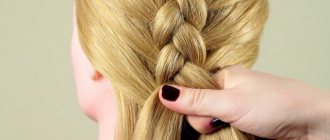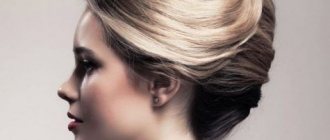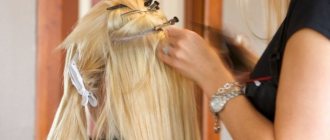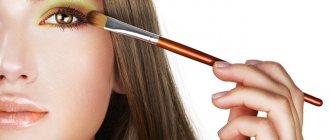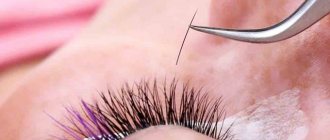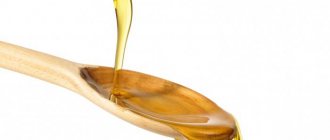- about the author
- VK profile
Svetlana Tarasova
Hairdresser-stylist with more than 8 years of experience, expert in the field of haircuts, styling, hair care, coloring.
The world recognized dreadlocks as a hairstyle in the 50s. It was invented in Jamaica. Nowadays, with the help of dreadlocks, people surprise society and express their rebellious, extraordinary nature. Let's look at what types of hairstyles there are, the technique for performing each, care and proper braiding.
Material selection
Not only the future of the hairstyle, but also its compatibility with natural hair depends on the quality of Kanekalon. You can find both cheap options and more expensive ones, which are additionally treated with protective agents and the hairstyle can be heat treated. Such dreadlocks can be straightened with special straightening irons or, conversely, given a wavy texture using hairsprays and medium-hold foam.
We will tell you further how to weave dreadlocks from Kanekalon using artificial or natural hair. Kanekalon is considered one of the safe materials that can be used even at home. It is better to buy natural hair or made from high quality materials.
You can find out about this directly from the manufacturer and pay attention to the price category. As for cheap Kanekalon, it can quickly get tangled with your natural hair and then it will be impossible to remove such dreadlocks.
The necessary elements for the master, which are used in the classical technology of creating dreadlocks, include the use of only hands.
Kanekalon is considered a lighter and more pleasant material. Therefore, with its slip level, it is advisable to use an additional hook, which allows you to quickly wind the strands and press them into dreadlocks. In addition, you may need a hair straightening iron, since in the process of attaching a dreadlock to natural hair, elements of the latter can become electrified.
How to weave dreadlocks from Kanekalon using low-quality material? It is better not to look for an answer to this question, since bad Kanekalon can damage the structure of your natural hair and lead to increased hair loss.
How to weave DE
DE dreadlocks are so popular because they do not damage the hair and are easily removed.
When forming them, the braiding begins from one's own hair into pigtails, and then strands of synthetic Kanekalon monofilament are added to them. This is a lightweight and soft artificial material.
The scheme for forming blanks for dreadlocks is simple, and in this lesson we will look at it step by step. For work you will need the following materials and tools:
- stationery erasers;
- small comb with a thin tail;
- scissors;
- spray;
- tripod or any device for securing material;
- hair straightener;
- kanekalon.
- Individual strands of the required thickness are selected from a common bundle of synthetic hair, secured on a tripod, and first one loose half is combed from the middle to the base. At home, you can fix your curls in any convenient place. After this stage, you can use a crochet hook to tighten the disheveled or uneven areas inside the curl.
- Next, twist the combed area about 10 centimeters long. The twisted strand should be tight so that the dreadlock does not turn out loose.
- When the spiral curl is ready, it is secured with a damp cloth and a hot iron. A hairdryer is often used at home.
- After this, continue twisting the strand and welding it in the next section. The second half of the kanekalon is formed according to the same pattern, securing the already finished half.
You can learn the sequence of work at this stage from the video.
User review of weaving

Anna, 21 years old, Ryazan
Having finished forming the blanks, they begin to weave them into the hair. For this procedure you need the following tools:
- Large clips for separating and fixing hair.
- Small clips for fixing small strands.
- Scissors, a spray bottle and a comb with a thin metal tail.
- Cotton threads.
Feedback on weaving

Veronica, 18 years old, Moscow
- Divide your hair into partings depending on its thickness. You need to start from the bottom of the back of the head, and then move to the temporal area of the head.

- The procedure is performed using the metal tail of a comb. The dreadlock blank is located in the center between two strands and is woven into the hair in a figure eight. As a result, from each dreadlock you get two.
- When small tips remain, add thread and continue weaving. At the end, a thread is wrapped around the joint. Then the knots are tied and the ends are cut off.
- The work continues by dividing the hair into sections and securing them with clips. Braid dreadlocks at your temples, then do it at the top of the back of your head.
- The crown is formed last and new dreadlocks are added in a checkerboard pattern so that they overlap each other.
If the braiding is done well, the hairstyle can be worn for 2 to 3 months, after which the locks are adjusted or unbraided. Caring for them is simple and involves washing your hair with shampoo once a week.
Preparation for the process
For a standard procedure that does not involve the creation of additional volume, use:
- two packs of Kanekalon;
- a rare comb with small teeth;
- small scissors;
- hair straightener;
- damp sponge or rag;
- packaging of thin elastic bands.
The latter can be replaced with threads, which are added directly during the process of creating dreadlocks and woven along the entire length of the hairstyle.
It is important, when you weave dreadlocks from Kanekalon, to monitor the condition and thickness of the selected strands. If they begin to get tangled during the weaving process, you should definitely use a comb so that the result does not disappoint you later.

What you need to weave yourself
It is possible to weave many types of dreadlocks yourself at home. This procedure does not require special skills or experience: the main thing is to remember two basic rules:
- the length of the hair should not be less than 15 cm, since after the formation of the dreadlock it will become shorter by one third;
- Thin, brittle and repeatedly dyed hair is not suitable for such hairstyles, as its condition will worsen even more.

kulagina_stylist

dollhouse_irk
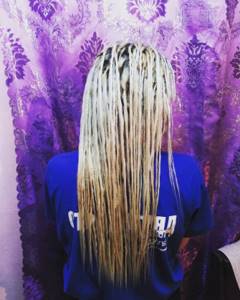
lianka_dm_
Before you start weaving, you need to prepare the following:
- hair dryer;
- wax intended for hair styling;
- small comb;
- special elastic bands;
- Kanekalon (synthetic strands of different lengths and colors).
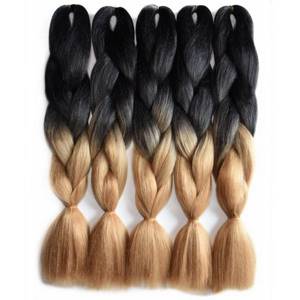
Detailed instructions
Before starting the procedure, be sure to comb the entire Kanekalon. To prevent tangling, an emulsion is used for easy combing. You can buy any products that you find in cosmetics stores.
Next, a small strand is separated and bent in half. An elastic band is tied to the bend; you can replace it with thread. To prevent the strand from moving during the process, it can be secured to any object. It is advisable to use one that is located directly near the place of work.
First, combing of one of the halves of the strand begins. This should be done from top to bottom gradually and without pulling the hair too much with the comb. After half the strand has been combed, you need to spray it with varnish, then quickly move the comb along the curl until you get a uniform tangle.
In order for the dreadlocks to turn out high-quality and even, you need to press them from time to time with a wet rag. When the tangle gets tangled, you need to twist it, preferably in one direction. Experts advise keeping it closer to the bottom, since if you do it from above, the quality may decrease.
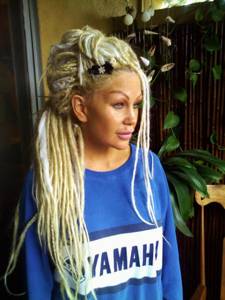
During the twisting process, pay attention to the thickness of the dreadlock, initially it depends on the strand of Kanekalon, which was taken as the basis for weaving. This way you get good dreadlocks. Kanekalon strands allow you to create an attractive hairstyle.
The next step is to wrap the dreadlock with a damp cloth, then use a heated straightener to pull it several times along the length of the curl, stopping at each section for about a few seconds.
In salons, foam or varnish is used in the process for better fixation. Then they do the same with the second half, and then with the whole dreadlock. It is advisable to trim any stray hairs with scissors during the creation of each element so that the result looks neat.
Heat treatment requires attention, since if the device is overexposed to a dreadlock, it can be burned.
How to make natural dreadlocks from natural hair?
There are several options and techniques for creating an unusual hairstyle. Dreadlocks that are made from your own strands are called dangerous. Before starting the procedure, you need to wash your hair. Hair should be smooth, manageable and dry.

ammashaa
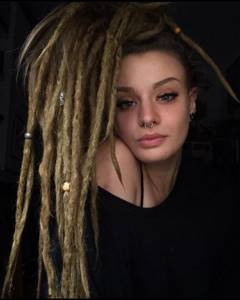
dreadstagram
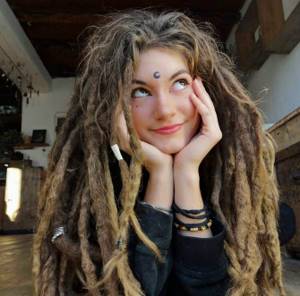
dreadsunshine
Bouffant
Step-by-step instructions for using combing:
- The weaving process should begin from the back of the head. You need to backcomb from the ends to the roots. At this time, it is necessary to make rotational movements until a bun is formed that cannot be combed.
- Then you need to roll the bun with your palms, like a sausage.
- Leave a small tip, about 1 centimeter, lubricate it well with wax, heat it with hot air from a hairdryer until the product is completely dry.

Crochet braids
For this method of weaving, you will need a hook measuring 1-1.6 mm, special hair wax, and elastic bands. The essence of the procedure is the following:
- You need to make markings on your head into identical segments - it can be in the form of squares or triangles. Secure each strand with a small hair tie.
- Take one strand and divide it in half, as if tearing it apart. The more you tighten the dreadlock, the thicker it will be. In this way, separate and twist the strand until one small tail remains.
- Now you need to start crocheting. It needs to be threaded through the dreadlock along its entire length, wrapped around it a few turns with the remaining tail, and pulled out. With these actions, the dreadlocks are fixed and become less shaggy.
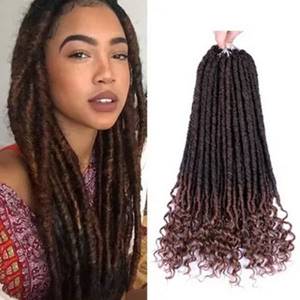
Interesting! The hook can be replaced with a regular guitar string. The effect will be identical.
Dreadlocks rubbed with wool
You can easily do this hairstyle yourself at home. Step by step execution:
- You need to take a scarf or other woolen product and rub it over the entire surface of your head until the hair rolls into one large tangle.
- Divide all curls into small equal parts.
- Apply a little wax to each dreadlock, roll them one by one for several minutes, and secure with thread.
- Any loose hairs should be threaded into the formed flagella using a hook.
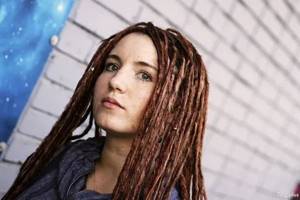
Rolled up
Rolled dreadlocks are a great way to style curly hair. The hairstyle is done this way:
- It is necessary to divide the entire mass of hair into strands.
- Take one strand, treat it with wax, scrolling clockwise.
- Using a thin comb, you need to knock down the strands at the ends in parallel. This is a fairly lengthy process that should be repeated over several days.

The result is neat, beautiful dreadlocks.
Industrial
To weave industrial dreadlocks you will need wax and wire. The essence of the procedure is the following:
- You need to divide your hair into equal small strands.
- Lubricate each one generously with wax.
- Place the wire in the middle of the strand and wrap it. You should get beautiful, uniform flagella.
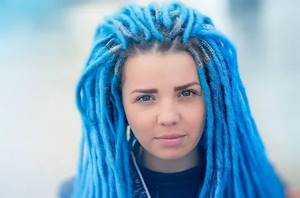
Industrial dreadlocks look unusual compared to regular ones. The advantage of this hairstyle is that each flagellum can be given any shape - the wire even allows you to create the appearance of twisted dreadlocks.
Wicker
It is important to know! Creating braided dreadlocks is one of the most painful types of creating a custom hairstyle.
Step-by-step instruction:
- Divide your hair into small strands and secure them with elastic bands.
- Starting from the frontal area, you should take one strand and twist it into a rope.
- With a sharp movement, you need to divide the resulting tourniquet into two parts, and a cracking sound should be heard. This moment is the most painful.
- Divide both parts in half again, make one binding, as when creating a pigtail.
- Repeat the procedure until the end of the strand.
- The resulting tourniquet must be lubricated with wax again.
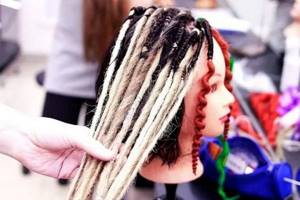
Braided dreadlocks are considered the most harmful method of creating a hairstyle, since unbraiding and combing the hair after this will be very problematic.
Permanent dreadlocks
This hairstyle looks quite stylish and elegant, but it is almost impossible to do it at home. Painstaking work can only be done by an experienced craftsman. You will need to go to him regularly for adjustments. Permanent dreadlocks require very careful care.

dreads_by_matityk

sol_in_tenebris
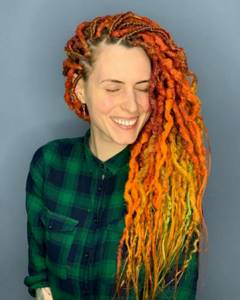
Gerts____
Twisting
To create this hairstyle, you need to take a hair wax, elastic bands and a comb. Step by step execution:
- Divide the entire hair into small strands in the form of squares. Twist each one clockwise, combing them at the roots.
- Secure the work with wax and the ends with an elastic band.
- Then continue rolling each strand with your palms for a month, also using wax.
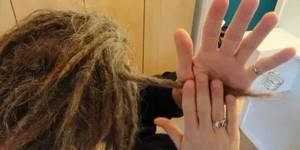
Twisting and tearing method
This method consists of the following steps:
- It is necessary to lather your hair with shampoo until a rich foam is obtained.
- Without rinsing off the shampoo, twist your hair clockwise.
- Rinse in water and let dry without combing.
- When the curls are completely dry, you need to break the formed tangle into many strands - each will be a dreadlock.
- Roll each strand in your palms, adding wax.
- The procedure should be repeated until the hair is completely dreadlocked.
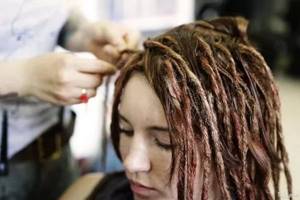
Ironing
This is the safest, but short-lived way to create dreadlocks. They will disappear after washing your hair. For the hairstyle you will need a straightener, comb and hairspray. Step-by-step instruction:
- Divide the hair into small strands.
- Twist a separate strand into a strand and make a backcomb along its entire length.
- Treat the entire flagellum with a hot iron, fix the result with varnish.
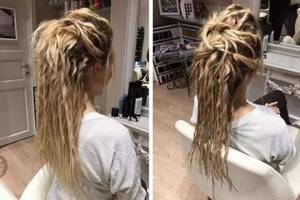
Useful tips
Although you can find a lot of information on how to make dreadlocks from Kanekalon, it is better to do it with a trusted specialist. If he has no experience in creating an image before, then it is better not to experiment, because the price may be your hair.
It is important to use a damp cloth while working. To retain moisture, you need to use a spray bottle. To correctly calculate dreadlocks, you need to take into account the fact that one finished dreadlock consists of 2 parts, which can be cut during the process if the length is too long. Foam should be used in moderation, since the tangle may become too dense, causing the surface of the dreadlock to change and become uneven.
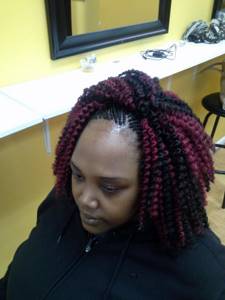
Hair tips
The ends of dreadlocks can also become unraveled over time. Find a place near the end of the curl where the hair is still perfectly curled. At this point, pierce the dreadlock through, using the same hook, wrap a narrow strand of the untwisted tip around it and pull it back. Repeat this function a couple of times until all the hair is braided. After all these manipulations, the end of the dreadlock will become shorter and take on an oval shape, and at the same time it will look tighter and more elastic.
Useful articles:
- How to make safe dreadlocks Dreadlocks are a typical hairstyle that is quite popular in a certain…
- How to make dreadlocks Dreadlocks are a good hairstyle for some, and one of...
- How to achieve soft, voluminous curls: summer fashion trend 2013 Beautiful, well-groomed hair is very important in the summer, because...
- 5 styling without any help You can look stylish and beautiful every day. To create some...
- How to do an informal hairstyle Informal hairstyles are a prestigious trend in recent seasons. Even strict business women...
Secrets with a hook
You can find many recommendations on how to make dreadlocks from Kanekalon. Thus, using a hook allows you to speed up the process of creating dreadlocks and simplify winding. As a result, the resulting elements will be equally smooth and dense enough for long-term use.
So, how to crochet dreadlocks from Kanekalon? The process is similar to creating a hairstyle with your hands, but here instead of fingers there will be a hook on which the strand is wound and then pulled down. Using a hook in your work allows you to speed up the procedure several times.
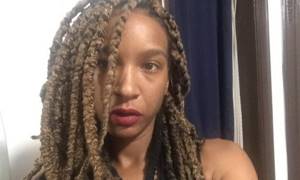
Lost strands
In the first month after creating dreadlocks on your head, the strands will constantly fall out, so you will have to twist them once a day. In the future, the curls will become more obedient and it will be possible to braid them only after washing your hair. It is always necessary to twist your hair exclusively in one direction, without changing it. Start from the roots and work your way evenly to the tip.
So, to braid a dreadlock, pierce it right through with a crochet hook so that the end of the hook comes out under the loose curl. Wrap the hook around this strand about two or three times and pull it to the other side of the dreadlock. Continue in this manner until all the strands are in their proper places. To keep your hair in place longer, you can fix it with wax or styling gel.
Hair care
Once you have decided to weave dreadlocks from Kanekalon with a crochet hook or your hands and attached them to your hair, you need to be careful when washing your hair. Even in the process of creating a hairstyle, you should take into account that your natural hair may not withstand too much stress, so a large strand is taken for attachment.
You need to wash your hair carefully, do not rub the dreadlocks together, spread a little shampoo on your palms and simply blot your hair with it, then rinse with warm water. It is not recommended to use a hairdryer during the drying process, as this may change the texture of the dreadlock.
As for hairstyle correction, it is done after about two to three months, depending on the growth of your own hair. If correction is not done in a timely manner, dreadlocks can greatly weigh down the hair, leading to tangling.
Kinds
Synthetic dreadlocks are safe and do not damage or injure your hair.
They are usually made from kanekalon, felted wool (felt) or natural donor hair. In the photo below you see an example of long and short felt dreadlocks, as in the photo.

Felt strands do not look as natural as kanekalon ones. The difference is that in the summer they will be too hot. At the same time, they have a wide variety of shades of any color, and in winter they will serve you as a hat. Kanekalon is visually different from felt.
All dreadlocks that are not formed from your own hair can be divided into categories depending on the methods of weaving:
- The classic version of a safe dreadlock looks almost like a natural one, but the master weaves Kanekalon into the lock with a braid, which he then disguises inside the hairstyle.
- Safe locks made of synthetic hair with one end called CE dreadlocks (single ended). The added strands can be close in color to the natural shade, or very different. If desired, the master will make the strands multi-colored.

- Analogues of CE locks are called DE (deadlocks). They have a double ended, and form twice the volume of the hairstyle, because from one braid you get two. They require a hair length of at least 7 cm. They are worn for about three months.

- Ja dreadlocks are smooth thanks to machine making. They are sold ready-made and can be woven point by point.

- The “Trash” (light) option involves a double technique, in which the braids must be braided manually.
Of all the above, DE dreadlocks are the most commonly woven. They are preferred by both women and men.
Choosing a Shampoo
Although Kanekalon is considered one of the most durable materials, if not properly cared for, the hairstyle can quickly lose its shape and turn into tow. To prevent this from happening, you need to pay attention to shampoo and care products, and use sulfate-free products.
This will help not only maintain your hair, but also your hairstyle in general. As for natural-based masks or products containing oil, it is better to avoid using them, as this will affect the density of the dreadlocks. It is also not recommended to make vitamin masks or use nicotinic acid, as it can change the color of the dreadlocks at the base.
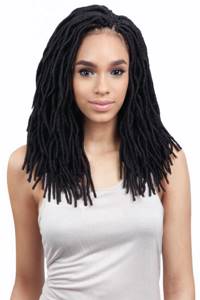
Caring for dreadlocks at home
The scalp may itch and flake after braiding. To calm it down, you need to regularly wipe the skin with chamomile decoction. It is also useful to rub the epidermis with wood ash. It copes well with itching and discomfort.

As for the dreadlocks themselves, in your free time they need to be periodically braided and twisted. The process of creating them is not a quick process, so it is not a fact that you will be able to achieve a beautiful result in the first month.
Dreadlocks are a modern hairstyle that has become the hallmark of modern youth subcultures. She is so loved by society that more and more people dare to “try” it on themselves.
- about the author
- VK profile
Help from stylists
One of the most important tips on how to weave dreadlocks with Kanekalon yourself remains the one given by experts - you shouldn’t do this without experience.
Although the dreadlock hairstyle allows you to stand out and be original, it is also used in exceptional cases with hair, as it helps to create additional volume. To do this, use several packs of Kanekalon, hair foam, and a comb with thick teeth to create a large backcomb.
For volume, you can ask stylists to create dreadlocks with additional African braids. But do not forget that in this case there should be more dreadlocks as a basis. This way the density will visually stand out and the hairstyle will be able to stay in place for a longer period of time.
You can learn how to make crochet dreadlocks from Kanekalon directly from the stylists. These dreadlocks include not only the base material, but also the use of tape and threads. Their thickness is several times greater in comparison with ordinary ones, due to which the required volume is created.
Safe dreadlocks
Dreadlocks are a very extravagant hairstyle, but in the process of creating it, the hair structure is severely damaged, so it is not immediately possible to return the curls to their former shine and silkiness after the strands are unraveled (or cut). As an alternative, craftsmen came up with so-called safe dreadlocks, which will be discussed below.
Dreadlocks with Kanekalon
This type of “safeties” allows you to create a hairstyle that closely resembles real dreadlocks without damaging your hair. The material used is Kanekalon - a synthetic fiber that imitates natural strands. Wigs are made from it, and specially prepared bundles are sold for dreadlocks. They can be of different shades - if you choose a color that is as similar as possible to the tone of your native hair, you can make safe dreadlocks, as experience shows, that will be very similar to natural ones.
How to make safe dreadlocks with Kanekalon?
Hair, first of all, should be washed and dried thoroughly. You cannot use emollients (oils, conditioners, balms).
The hair is parted into equal squares of 1.5 or 2 cm, starting from the back of the head. If you adhere to a checkerboard pattern, safe dreadlocks will turn out more neat, and bald spots will not be visible. The separated strands are secured at the roots with small elastic bands.
Weaving safe dreadlocks, as a rule, starts from the bottom. One of the strands on the back of the head is freed from the elastic band, divided into three parts and we begin to weave a regular braid, weaving Kanekalon blanks into it. Artificial strands should be twice as long as natural hair. When the braid is ready, the remainder of the Kanekalon dreadlock is wrapped around it from bottom to top. To prevent the resulting bundle from becoming frizzy, it is treated with dreadlock wax. The same is done with the remaining strands.
This hairstyle can be worn for about 3 months; when the hair grows back, safe dreadlocks can be unbraided like regular braids.
DE dreadlocks
Another variety is the so-called “de dreadlocks”, which involve the use of blanks made of kanekalon, felt or wool. They can be either “natural” colors or bright ones. Such safe dreadlocks can be safely called false dreadlocks - natural hair is simply wrapped around them at the base. With the help of multi-colored blanks, it is possible to create an extravagant image, but the roots of living hair will still be visible, and this should be taken into account.
How to braid safe DE dreadlocks?
To create such a hairstyle, you will need a comb, small elastic bands, hair clips, blank dreadlocks, and a crochet hook. The hair should be washed without balm, dried, and combed.
- A hole is made at the base of the workpiece using a hook.
- Hair is divided into strands. If you have a good eye, it is not necessary to divide all your hair into sectors at once. It is better to start from the back of the head.
- Thread a strand into the hole made in the workpiece, helping yourself with a hook.
- The threaded strand is divided in half and wrapped in parts around the dreadlock at the base. The place of the winding is fixed with a rubber band.
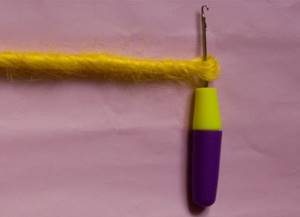
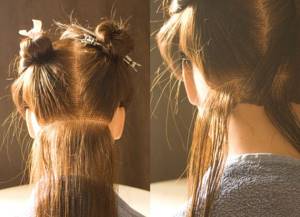
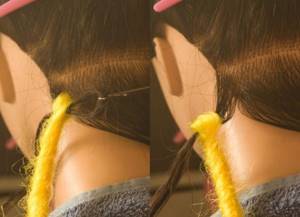
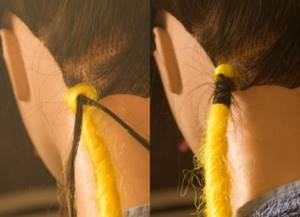
The same is done with the remaining strands. These safe dreadlocks are easy to make at home. They last for about 2-3 months: when the hair grows back, the pieces can be unbraided and reused.
Another weaving method is the “figure eight”, when hair is wrapped around the middle of the workpiece, and then the dreadlock has two ends. That is why the name has the prefix DE - short for double ended (double-sided).
“Safeties” are washed once a week. Kanekalon is afraid of high temperatures, so you will have to give up a hair dryer, as well as going to the sauna. Dreadlocks made of wool/felt begin to smell unpleasant when wet. Some people may be allergic to these materials, so if severe itching and redness of the scalp occurs, safe dreadlocks should be immediately unraveled.
